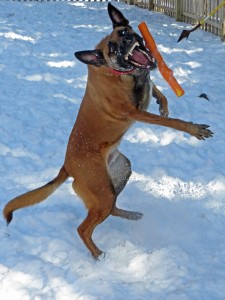The Power of Choice
During this most recent stretch of frigid (though not quite the ‘extreme cold’ of a month ago), I have had to improvise the activities happening with my mid-day dog walking clients. It has simply been too cold to spend much time outside, even when layered up like crazy. So, one of the activities I have decided to work on is teaching Bear, the malinois, to drop toys to my hand. He doesn’t have a reliable drop on cue and never gives to hand (not even for his owners). He is a dog who lives for his toys and is a little insecure about relinquishing possession to a hand because he also would LOVE to tug (but has never been permitted to tug, so hasn’t learned rules).
Bear is a lower drive malinois…but is still a medium/high drive dog. He knows that he must drop the toy in order for me to throw it again, but I would not say he knows ‘drop’ reliably outside the context of fetch. We’ve worked on some impulse control issues that he’s had with me while playing fetch (coming up snapping at me to get a frisbee in my hand that I didn’t throw immediately, or lunging and snapping at a disc on the ground that I was reaching for, or not dropping the disc for me and then dropping it in a certain part of the yard and barking at it out of frustration) but I wanted to try and teach him to drop to my hand so I didn’t have to put my hand in the snow to pick up the toy (which caused my fingers to get cold/wet quicker, even with gloves) and maybe speed up our games of fetch.
I started out using a lower value toy inside the house–since he is way more toy motivated than food motivated, I opted to just use toys as a reward instead of food. I would grab his collar (to prevent him from regripping the toy while pushing it into my hand, causing an accidental bite–i learned that the hard way), pretend to grab the toy but only put my hand under the toy, not actually grip it, and then cue the drop. If he tried to pull the toy back and tug, he would get no resistance since I wasn’t actually holding the toy. It took a while but he eventually dropped the toy and it stayed in my hand. I marked it with a “yes” and immediately tossed the toy back to him. I repeated this any time he tried to push the toy into my hand instead of just dropping it at my feet.
I worked on this for three of the coldest days inside and increased the criteria of actually having a grip on the toy when he dropped it, responding to the drop without my hand on his collar (and, more importantly, no re-gripping), and started to build the arousal level of the game. He picked up this new skill pretty quickly in the the house with the lower value toy. It was clear, however, that it was really hard for him to drop to my hand. There were shake-offs, some moments of stillness where he just THOUGHT about whether he could let go if I had the toy as well, and some tension in his face when he was making the choice between dropping or yanking back to try and tug (I could totally see his gears turning). I never forced him to put the toy in my hand to play the game, if he spit it out on the floor, the toy got tossed regardless. Although a simple skill, it was incredibly hard for him to trust enough to let go if I also had the toy, but the more he practiced the more relaxed he got.
Last week and the week before, as the temperatures increased a bit, we got outside to run a bit and I tried introducing the drop to my hand outside. I only asked for the drop to my hand when he made the choice to push the toy into my hand. The first time we played, he voluntarily did 5 drops to my hand within the 25 minute play time and dropped it at my feet the rest of the time. He would do two or three drops to my hand and then drop it on the ground. For each drop to my hand, he got lots of verbal praise and cheering as a bonus reward to the toy being thrown. I was pleased with his offering to drop to my hand a few times during our game! It was also interesting that he would offer a shake-off after the second or third drop to hand and then go back to dropping on the floor–he had reached his limit and needed a break.
The following day I played the same game and was shocked when he offered a drop to my hand time and time again for a total of 16 times during our play session. Again, he seemed to choose to drop to my hand in spurts–but this time it was about 5 drops to my hand before he would drop the toy to the ground for a while. Again, he seemed to do a shake off every time he had ‘had enough’ of dropping to my hand and needed a break from doing something he finds incredibly challenging.
The third time I played this game, we got about 20 drops to my hand reliably!
Each time we played I gave him complete control–he could drop the toy at my feet and I’d throw it or he could bring it to my hand and drop it and I’d throw it. With the control and choice in his hands, he started offering the behavior that he finds challenging more and more often. There were no consequences for not doing the more challenging skill but there was a bonus for choosing to do it (me cheering him on and acting silly with him). If I had forced him to drop to my hand and put pressure on him for that behavior, I know that two things would have happened: 1. he would have felt more stressed and uncomfortable about relinquishing the toy to my hand over time 2. the likeliness of him choosing to drop to my hand would have been reduced.
Forcing a dog to do a behavior that makes them feel uncomfortable over and over again, does not necessarily help them feel more comfortable with that behavior and doesn’t mean the behavior will be offered more often. By giving Bear the choice to offer the behavior … or not… he was in control of the situation and could offer the behavior he wanted. With the control in his paws, Bear started offering the challenging behavior more and more frequently and the behavior became less challenging and less stressful for him through practice.
Choice and control can’t always be given to the dog (depending on the behavior or situation) but when you can, it can be incredibly beneficial in the long run!


